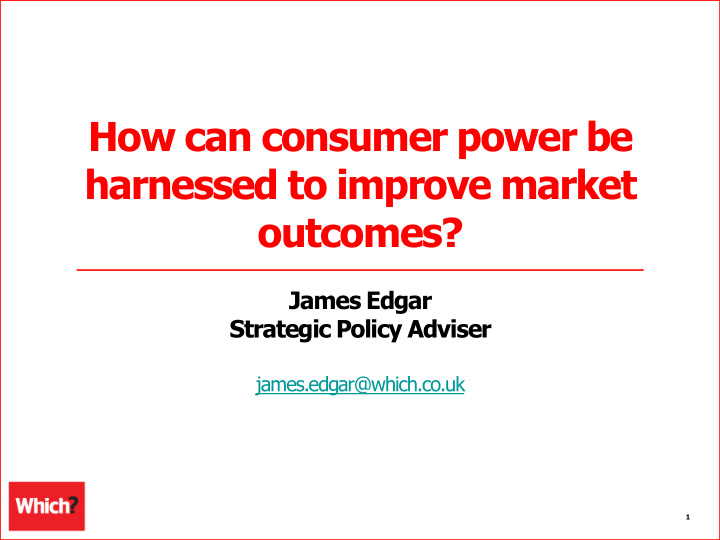



How can consumer power be harnessed to improve market outcomes? James Edgar Strategic Policy Adviser james.edgar@which.co.uk 1
Summary These slides were presented by James Edgar of Which? at the launch workshop of the UKCN c onsume r r emedies project (titled ‘linkages between consumer behaviour and remedies’) held at the Competition and Markets Authority on 20 September 2016. This presentation formed part of a joint presentation that was given together with Amelia Fletcher of the University of East Anglia. This presentation related to the joint work carried out by Which? and Amelia on demand-side remedies. James first describes the cross-sector policy that Which? applied when assessing the functioning of markets and then provides an example of an intervention by Which? into the credit cards market. James next presents a case study of a past intervention by the Office of Fair Trading in the market for extended warranties for domestic electrical goods. Finally, James refers to Amelia’s report on demand-side remedies to draw a series of conclusions concerning how regulators should diagnose and 2 remedy issues in consumer-facing markets.
Cross-sector policy 3
Which? 4
Case study: Extended Warranties for Domestic Electrical Goods In 2002 OFT published findings and referred the market to the Competition Commission. CC imposed four remedies through an Order in 2005: i. Retailers to display prominently freely- available information leaflets ii. Retailers to display price and duration information adjacent to the price of the good iii. Requirement for retailers, upon request to provide a written quotation that guarantees that the extended warranty will be available on the same terms for 30 days if the consumer chooses not to buy it at that time iv. Increased rights for consumers to cancel a purchased extended warranty 5
Case study: Extended Warranties for Domestic Electrical Goods In 2008 OFT evaluated the impact of the remedies and found limited impact because of limited compliance: i. a lack of ‘prominently displayed’ leaflets ii. around 45% of the retailers visited in a mystery shop were not displaying the required information next to any of the relevant products iii. up to a third of sales assistants giving the wrong information on consumers’ rights Some positive impacts, with the evaluation finding: an increase from 4% to 15% in the proportion • of consumers who considered alternative offers from those offered at the point of sale • that 5% of consumers had used the improved cancellation rights 6
Case study: Extended Warranties for Domestic Electrical Goods OFT returned to this subject in 2012, because of a persisting advantage for selling extended warranties at point-of-sale and limited shopping around. T ook Undertakings-In- Lieu from major players in the market to establish, maintain and participate in a comparison website and publicise it in prominent positions. 7
What do we think Amelia’s findings tell us? Is the disengaged consumer the problem? Why isn’t the market engaging consumers? Can new entrants disrupt the incumbents? Or will outcomes need to be directly controlled? Regulators may get drawn too far in to the design of remedies Can a market for information provision be created? What should the regulator be responsible for? Can firms be held to account for outcomes, not process? Use Review points, with associated action 8
What do we think Amelia’s findings tell us ? The largest cost to consumers is ineffective remedies, not testing and evaluation Testing very important, although only evaluations can tell us about supply side response Good consumer outcomes are not always driven by switching Powerful and incentivised Consumer Challenge Groups 9
Recommend
More recommend